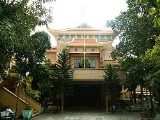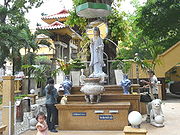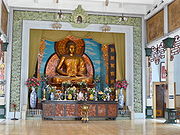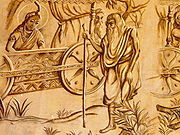
Xa Loi Pagoda
Encyclopedia
The Xá Lợi Pagoda is the largest pagoda in Ho Chi Minh City
, Vietnam
. It was built in 1956 and was the headquarters of Buddhism
in South Vietnam
. The pagoda is located at 89 Bà Huyện Thanh Quan Street in District 3, Ho Chi Minh City and lies on a plot of 2500 square metres. The name Xá Lợi is the Vietnamese
translation for sarira
, a term used for relics of Buddhists.
The pagoda is most well known abroad for the Xá Lợi Pagoda raids
, in which the Army of the Republic of Vietnam Special Forces
loyal to Ngô Đình Nhu
, the brother of the Roman Catholic President Ngô Đình Diệm, raided and vandalised the pagodas on August 21, 1963.
of Gautama Buddha
, giving its name.
, the birthday of Gautama Buddha
. In May 1963, a law against the flying of religious flags was selectively invoked; the Buddhist flag
was banned from display on Vesak
while the Vatican flag was displayed to celebrate the anniversary of the consecration of Archbishop Ngo Dinh Thuc, Diệm's brother. The Buddhists defied the ban and a protest was ended when government forces opened fire. With Diệm remaining intransigent in the face of escalating Buddhist demands for religious equality, sections of society began calling for his removal from power. The protests were orchestrated from within Xá Lợi, where thousands of monks arrived from across South Vietnam to organise demonstrations, hunger strikes, organise media releases and print pamphlets. The government of Diệm was unable to break the protestors, and demonstrations increased throughout the summer.
However, the movement was broken with a series of raids on pagodas and monasteries across South Vietnam. Squads of Special Forces, led by Le Quang Tung
and combat police flattened the gates and smashed their way into the pagoda at around 00:20 on August 21, 1963, as Xá Lợi's brass gong was clanged as a warning signal of the attack. Nhu's men were armed with pistols, submachine guns, carbines, shotguns, grenades and tear gas. The red bereted Special Forces were joined by truckloads of steel-helmeted combat police in army camouflage uniforms. Monks and nuns who barricaded themselves behind wooden shields were attacked with rifle butts and bayonets. The gong of the pagoda was drowned out by the burst of automatic weapons fire, the sound of exploding grenades, shattering glass and human screaming. One monk was thrown from the balcony down to the courtyard 6 meters below. Nhu's men vandalized the main altar and managed to confiscate the intact charred heart of Thich Quang Duc, the monk who had self-immolated in protest against the policies of the regime. The Buddhists managed to escape with a receptacle with the remainder of his ashes. Two monks jumped the back wall of the pagoda into the grounds of the adjoining US Aid Mission, where they were given asylum. Thich Tinh Khiet, the 80 year old Buddhist patriarch of Vietnam, was seized and taken to a military hospital on the outskirts of Saigon. The commander of the III Corps of the ARVN, General Ton That Dinh
, soon announced military control over Saigon, canceling all commercial flights into the city and instituting press censorship. Across the country, hundreds were estimated to have died or vanished, and more than one thousand monks were incarcerated.
 The site includes a number of buildings, including the main ceremonial hall and the bell tower. The pagoda is separated from the street by a gated fence. Inside the fence is a popular Chinese-style statue of Quan Am holding a vial of elixir in one hand and making the gesture
The site includes a number of buildings, including the main ceremonial hall and the bell tower. The pagoda is separated from the street by a gated fence. Inside the fence is a popular Chinese-style statue of Quan Am holding a vial of elixir in one hand and making the gesture
of removing obstacles with the other.
.
 The statue of Gautama depicts the Buddha seated in meditation on a lotus blossom. He is wearing the garb of a monk. As usual, he is depicted with ears lengthened by the use of jewelry (indicating his royal origins), closely cropped curly hair (indicating renunciation of the worldly life), and a large protuberance on his head (indicating aptitude). Behind his head is a sun disc. This statue was crafted by sculptors from Bien Hoa
The statue of Gautama depicts the Buddha seated in meditation on a lotus blossom. He is wearing the garb of a monk. As usual, he is depicted with ears lengthened by the use of jewelry (indicating his royal origins), closely cropped curly hair (indicating renunciation of the worldly life), and a large protuberance on his head (indicating aptitude). Behind his head is a sun disc. This statue was crafted by sculptors from Bien Hoa
, a city just north of Ho Chi Minh City. It has been in its current state since 1969, when a gold coating was applied to it.
In front of the statue of Gautama Buddha is the shrine dedicated to the relics of the Buddha, with the relics being held in a small stupa
. Toward the front of the shrine is a small porcelain image of the "Laughing Buddha" Maitreya
, the Buddha of the future. Between the small statue of Maitreya and the large statue of Gautama is a golden image of multi-armed Cundi (Chuan De) bodhisattva
sitting in meditation on a lotus blossom. The bodhisattva
's many hands grasp familiar attributes such as the sword, the wheel, and the trident. Elegant Chinese-style vases on either side of the shrine hold flowers of various colors.
, from his birth as Prince Siddhartha to his attainment of nirvana. The images were created by Dr. Nguyen Van Long of the Gia Dinh Art School. Arranged sequentially high on the two side walls, the images are reminiscent of the depictions of the life of Jesus
or of the stations of the cross
found in some Christian churches. The fourteen scenes are as follows:

Above the entrance, facing the shrine itself, is an especially big image of Gautama Buddha seated in meditation underneath a fig tree.
 The bell tower of Xá Lợi Pagoda was opened in 1961. The tower stands 32 m, has seven stories, and is the highest bell tower in Vietnam
The bell tower of Xá Lợi Pagoda was opened in 1961. The tower stands 32 m, has seven stories, and is the highest bell tower in Vietnam
. On the highest level, there is a bell weighing two tonnes, which was cast in the model of the bell of Thiên Mụ Pagoda
in Huế
.
Ho Chi Minh City
Ho Chi Minh City , formerly named Saigon is the largest city in Vietnam...
, Vietnam
Vietnam
Vietnam – sometimes spelled Viet Nam , officially the Socialist Republic of Vietnam – is the easternmost country on the Indochina Peninsula in Southeast Asia. It is bordered by China to the north, Laos to the northwest, Cambodia to the southwest, and the South China Sea –...
. It was built in 1956 and was the headquarters of Buddhism
Buddhism in Vietnam
Buddhism in Vietnam as practiced by the ethnic Vietnamese is mainly of the Mahāyāna tradition. Buddhism came to Vietnam as early as the 2nd century CE through the North from Central Asia and via Southern routes from India...
in South Vietnam
South Vietnam
South Vietnam was a state which governed southern Vietnam until 1975. It received international recognition in 1950 as the "State of Vietnam" and later as the "Republic of Vietnam" . Its capital was Saigon...
. The pagoda is located at 89 Bà Huyện Thanh Quan Street in District 3, Ho Chi Minh City and lies on a plot of 2500 square metres. The name Xá Lợi is the Vietnamese
Vietnamese language
Vietnamese is the national and official language of Vietnam. It is the mother tongue of 86% of Vietnam's population, and of about three million overseas Vietnamese. It is also spoken as a second language by many ethnic minorities of Vietnam...
translation for sarira
Sarira
Śarīra are generic terms for "Buddhist relics", although in common usage these terms usually refer to a kind of pearl or crystal-like bead-shaped objects that are purportedly found among the cremated ashes of Buddhist spiritual masters...
, a term used for relics of Buddhists.
The pagoda is most well known abroad for the Xá Lợi Pagoda raids
Xa Loi Pagoda raids
The Xa Loi Pagoda raids were a series of synchronized attacks on various Buddhist pagodas in the major cities of South Vietnam shortly after midnight on August 21, 1963...
, in which the Army of the Republic of Vietnam Special Forces
Army of the Republic of Vietnam Special Forces
The Army of the Republic of Vietnam Special Forces were the elite military units of the Army of the Republic of Vietnam . Following the establishment of the Republic of Vietnam in October 1955, the Special Forces were formed at Nha Trang in February 1956...
loyal to Ngô Đình Nhu
Ngo Dinh Nhu
Ngô Ðình Nhu was the younger brother and chief political advisor of South Vietnam's first president, Ngô Ðình Diệm. Nhu was widely regarded as the architect of the Ngô family's nepotistic and autocratic rule over South Vietnam from 1955 to 1963...
, the brother of the Roman Catholic President Ngô Đình Diệm, raided and vandalised the pagodas on August 21, 1963.
Construction
Construction began on August 5, 1956, according to the plans drawn up by the architects Trần Văn Đường and Đỗ Bá Vinh, while the directing engineers were Dư Ngọc Ánh and Hồ Tố Thuận. The pagoda was opened on May 2, 1958, by the Most Venerable Thich Khanh Anh. The pagoda was built to enshrine a sample of the relicsSarira
Śarīra are generic terms for "Buddhist relics", although in common usage these terms usually refer to a kind of pearl or crystal-like bead-shaped objects that are purportedly found among the cremated ashes of Buddhist spiritual masters...
of Gautama Buddha
Gautama Buddha
Siddhārtha Gautama was a spiritual teacher from the Indian subcontinent, on whose teachings Buddhism was founded. In most Buddhist traditions, he is regarded as the Supreme Buddha Siddhārtha Gautama (Sanskrit: सिद्धार्थ गौतम; Pali: Siddhattha Gotama) was a spiritual teacher from the Indian...
, giving its name.
Protests and raids in 1963
South Vietnam's Buddhist majority had long been discontented with the strong favouritism shown by Diệm towards his fellow Roman Catholics. Discontent with Diệm and Nhu exploded into mass protest during the summer of 1963 when nine Buddhists died at the hand of Diệm's army and police on VesakVesak
Vesākha is a holiday observed traditionally by Buddhists in Bangladesh, India, Nepal, Sri Lanka, and the South East Asian countries of Singapore, Vietnam, Thailand, Cambodia, Laos, Malaysia, Burma, and Indonesia...
, the birthday of Gautama Buddha
Gautama Buddha
Siddhārtha Gautama was a spiritual teacher from the Indian subcontinent, on whose teachings Buddhism was founded. In most Buddhist traditions, he is regarded as the Supreme Buddha Siddhārtha Gautama (Sanskrit: सिद्धार्थ गौतम; Pali: Siddhattha Gotama) was a spiritual teacher from the Indian...
. In May 1963, a law against the flying of religious flags was selectively invoked; the Buddhist flag
Buddhist flag
The Buddhist flag is a flag designed in the late 19th century to symbolise and universally represent Buddhism. It is used by Buddhists throughout the world.-History:...
was banned from display on Vesak
Vesak
Vesākha is a holiday observed traditionally by Buddhists in Bangladesh, India, Nepal, Sri Lanka, and the South East Asian countries of Singapore, Vietnam, Thailand, Cambodia, Laos, Malaysia, Burma, and Indonesia...
while the Vatican flag was displayed to celebrate the anniversary of the consecration of Archbishop Ngo Dinh Thuc, Diệm's brother. The Buddhists defied the ban and a protest was ended when government forces opened fire. With Diệm remaining intransigent in the face of escalating Buddhist demands for religious equality, sections of society began calling for his removal from power. The protests were orchestrated from within Xá Lợi, where thousands of monks arrived from across South Vietnam to organise demonstrations, hunger strikes, organise media releases and print pamphlets. The government of Diệm was unable to break the protestors, and demonstrations increased throughout the summer.
However, the movement was broken with a series of raids on pagodas and monasteries across South Vietnam. Squads of Special Forces, led by Le Quang Tung
Le Quang Tung
Colonel Lê Quang Tung was the commander of the Army of the Republic of Vietnam Special Forces under the command of Ngo Dinh Nhu, the brother of South Vietnam's president, Ngo Dinh Diem. A former servant of the Ngô family, Tung's military background was in security and counterespionage...
and combat police flattened the gates and smashed their way into the pagoda at around 00:20 on August 21, 1963, as Xá Lợi's brass gong was clanged as a warning signal of the attack. Nhu's men were armed with pistols, submachine guns, carbines, shotguns, grenades and tear gas. The red bereted Special Forces were joined by truckloads of steel-helmeted combat police in army camouflage uniforms. Monks and nuns who barricaded themselves behind wooden shields were attacked with rifle butts and bayonets. The gong of the pagoda was drowned out by the burst of automatic weapons fire, the sound of exploding grenades, shattering glass and human screaming. One monk was thrown from the balcony down to the courtyard 6 meters below. Nhu's men vandalized the main altar and managed to confiscate the intact charred heart of Thich Quang Duc, the monk who had self-immolated in protest against the policies of the regime. The Buddhists managed to escape with a receptacle with the remainder of his ashes. Two monks jumped the back wall of the pagoda into the grounds of the adjoining US Aid Mission, where they were given asylum. Thich Tinh Khiet, the 80 year old Buddhist patriarch of Vietnam, was seized and taken to a military hospital on the outskirts of Saigon. The commander of the III Corps of the ARVN, General Ton That Dinh
Ton That Dinh
Major General Tôn Thất Đính is a retired officer who served in the Army of the Republic of Vietnam . He is best known as one of the key figures in the November 1963 coup that deposed and resulted in the assassination of Ngo Dinh Diem, the first president of the Republic of Vietnam .A favourite of...
, soon announced military control over Saigon, canceling all commercial flights into the city and instituting press censorship. Across the country, hundreds were estimated to have died or vanished, and more than one thousand monks were incarcerated.
Administrative function
Xá Lợi Pagoda served as the headquarters of the Vietnamese Buddhist Association until 1981, and as its second office until May 1993.Site

Mudra
A mudrā is a symbolic or ritual gesture in Hinduism and Buddhism. While some mudrās involve the entire body, most are performed with the hands and fingers...
of removing obstacles with the other.
Main ceremonial hall
The main hall of the pagoda is located on the upper level. Men ascend by the stairs on the left hand side, women by those on the right. The hall is rectangular in shape, and is supported by pillars. Facing the entrance is the shrine, which is dominated by a large statue of Gautama BuddhaGautama Buddha
Siddhārtha Gautama was a spiritual teacher from the Indian subcontinent, on whose teachings Buddhism was founded. In most Buddhist traditions, he is regarded as the Supreme Buddha Siddhārtha Gautama (Sanskrit: सिद्धार्थ गौतम; Pali: Siddhattha Gotama) was a spiritual teacher from the Indian...
.
Shrine

Bien Hoa
Biên Hòa is a city in Dong Nai province, Vietnam, about east of Ho Chi Minh City , to which Bien Hoa is linked by Vietnam Highway 1.- Demographics :In 1989 the estimated population was over 300,000. In 2005, the population wss 541,495...
, a city just north of Ho Chi Minh City. It has been in its current state since 1969, when a gold coating was applied to it.
In front of the statue of Gautama Buddha is the shrine dedicated to the relics of the Buddha, with the relics being held in a small stupa
Stupa
A stupa is a mound-like structure containing Buddhist relics, typically the remains of Buddha, used by Buddhists as a place of worship....
. Toward the front of the shrine is a small porcelain image of the "Laughing Buddha" Maitreya
Maitreya
Maitreya , Metteyya , or Jampa , is foretold as a future Buddha of this world in Buddhist eschatology. In some Buddhist literature, such as the Amitabha Sutra and the Lotus Sutra, he or she is referred to as Ajita Bodhisattva.Maitreya is a bodhisattva who in the Buddhist tradition is to appear on...
, the Buddha of the future. Between the small statue of Maitreya and the large statue of Gautama is a golden image of multi-armed Cundi (Chuan De) bodhisattva
Bodhisattva
In Buddhism, a bodhisattva is either an enlightened existence or an enlightenment-being or, given the variant Sanskrit spelling satva rather than sattva, "heroic-minded one for enlightenment ." The Pali term has sometimes been translated as "wisdom-being," although in modern publications, and...
sitting in meditation on a lotus blossom. The bodhisattva
Bodhisattva
In Buddhism, a bodhisattva is either an enlightened existence or an enlightenment-being or, given the variant Sanskrit spelling satva rather than sattva, "heroic-minded one for enlightenment ." The Pali term has sometimes been translated as "wisdom-being," although in modern publications, and...
's many hands grasp familiar attributes such as the sword, the wheel, and the trident. Elegant Chinese-style vases on either side of the shrine hold flowers of various colors.
Scenes from the life of Gautama Buddha
The walls of the main hall play host to a sequence of large panels depicting fourteen scenes from the life of the Gautama BuddhaGautama Buddha
Siddhārtha Gautama was a spiritual teacher from the Indian subcontinent, on whose teachings Buddhism was founded. In most Buddhist traditions, he is regarded as the Supreme Buddha Siddhārtha Gautama (Sanskrit: सिद्धार्थ गौतम; Pali: Siddhattha Gotama) was a spiritual teacher from the Indian...
, from his birth as Prince Siddhartha to his attainment of nirvana. The images were created by Dr. Nguyen Van Long of the Gia Dinh Art School. Arranged sequentially high on the two side walls, the images are reminiscent of the depictions of the life of Jesus
Jesus
Jesus of Nazareth , commonly referred to as Jesus Christ or simply as Jesus or Christ, is the central figure of Christianity...
or of the stations of the cross
Stations of the Cross
Stations of the Cross refers to the depiction of the final hours of Jesus, and the devotion commemorating the Passion. The tradition as chapel devotion began with St...
found in some Christian churches. The fourteen scenes are as follows:
- Queen MayaQueen MayaQueen Māyā of Sakya was the birth mother of the historical Gautama Buddha, Siddhārtha of the Gautama gotra, and sister of Mahāpajāpatī Gotamī the first Buddhist nun ordained by the Buddha. "Māyā" means "illusion" or "enchantment" in Sanskrit and Pāli. Māyā is also called Mahāmāyā and Māyādevī...
, the mother of the historical Buddha, dreams that an elephant with six tusks enters her through her right side. - The young Siddhartha walks on open lotusLotus (plant)Lotus identifies various plant taxa:* Nelumbo, a genus of aquatic plants with showy flowers** Nelumbo nucifera, the Sacred or Indian lotus** Nelumbo lutea, the American or Yellow lotus...
flowers, pointing at the Heaven and the Earth. - The elder Asita notes the auspicious marks on the body of the infant Siddhartha that indicate he will be a great secular or religious leader.

- Prince Siddhartha sees an old man and a sick man, leading him to ponder the devastation to the human body caused by old age and disease.
- The prince sees a corpse, and then a monk who is in perfect condition.
- Having decided to renounce the secular life and to lead a life of religion, the prince looks for the last time upon his family as they lie sleeping.
- Having left the royal city of KapilavastuKapilavastuKapilavastu is the name of a region of ancient Shakya kingdom that is considered a holy pilgrimage place for Buddhists. The search for the Buddha's birthplace following the accounts left by Xuanzang and Faxian involved various searches in the late 19th century...
with his horse KanthakaKanthakaKanthaka was a favourite white horse of length eighteen cubits that was a royal servant of Prince Siddhartha, who later became Gautama Buddha. Siddhartha used Kanthaka in all major events described in Buddhist texts prior to his renunciation of the world...
and horseman ChannaChannaChanna is a genus of the Channidae family of snakehead fishes. This genus contains about 29 species, but the most well known are probably northern snakehead and the giant snakehead . Channa has a wide natural distribution extending from Iran in the West, to China in the East, and parts of Siberia...
, Siddhartha cuts off his long hair in order to symbolize his entry into the religious life. - Three demon princesses representing ambition, anxiety, and voluptuousness try unsuccessfully to seduce the prince.
- MaraMara (demon)In Buddhism, Māra is the demon that tempted Gautama Buddha by trying to seduce him with the vision of beautiful women who, in various legends, are often said to be Mara's daughters. In Buddhist cosmology, Mara personifies unwholesome impulses, unskillfulness, the "death" of the spiritual life...
the king of demons and his minions attempt unsuccessfully to intimidate the prince by violence. - Having attained Enlightenment, Gautama BuddhaGautama BuddhaSiddhārtha Gautama was a spiritual teacher from the Indian subcontinent, on whose teachings Buddhism was founded. In most Buddhist traditions, he is regarded as the Supreme Buddha Siddhārtha Gautama (Sanskrit: सिद्धार्थ गौतम; Pali: Siddhattha Gotama) was a spiritual teacher from the Indian...
preaches the Four Noble TruthsFour Noble TruthsThe Four Noble Truths are an important principle in Buddhism, classically taught by the Buddha in the Dharmacakra Pravartana Sūtra....
to his first four disciples in the garden. - A young woman falsely accuses the Buddha of getting her pregnant, as the Buddha makes the gestureMudraA mudrā is a symbolic or ritual gesture in Hinduism and Buddhism. While some mudrās involve the entire body, most are performed with the hands and fingers...
of calling upon the Earth as a witness; the Buddha instructs another young woman. - Elephants and other animals render hommage to Buddha; Buddha converts the venomous serpents.
- The Buddha converts Angulimala, an armed assassin.
- Lying on his side, the Buddha enters into nirvana.
Above the entrance, facing the shrine itself, is an especially big image of Gautama Buddha seated in meditation underneath a fig tree.
Bell tower

Vietnam
Vietnam – sometimes spelled Viet Nam , officially the Socialist Republic of Vietnam – is the easternmost country on the Indochina Peninsula in Southeast Asia. It is bordered by China to the north, Laos to the northwest, Cambodia to the southwest, and the South China Sea –...
. On the highest level, there is a bell weighing two tonnes, which was cast in the model of the bell of Thiên Mụ Pagoda
Thien Mu Pagoda
Thien Mu Pagoda is a historic temple in the city of Huế in Vietnam. Its pagoda has seven storeys and is the tallest in Vietnam. The temple is often the subject of folk rhymes and ca dao about Huế, such is its iconic status and association with the city...
in Huế
Hue
Hue is one of the main properties of a color, defined technically , as "the degree to which a stimulus can be describedas similar to or different from stimuli that are described as red, green, blue, and yellow,"...
.

